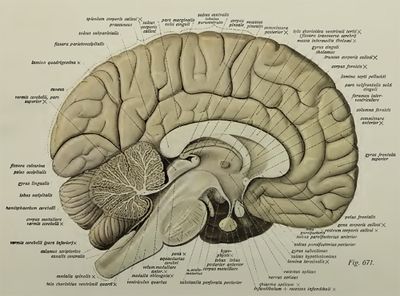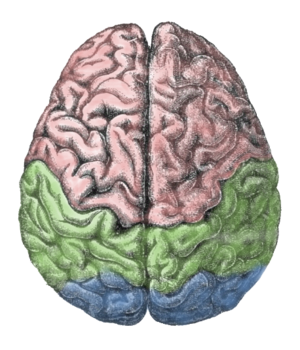Brain

The brain (Latin: cerebrum; Greek: Ενκέφαλον encephalon "in the head", from εν en "in" and κεφαλή kephalé "head") is the part of the central nervous system (CNS) of vertebrates and humans that lies protected in the cranial cavity. The physical brain is built up and constantly regenerated (especially during sleep) by the underlying etheric brain.
The brain and the spinal cord located in the vertebral canal (Canalis vertebralis) are surrounded by two soft (Pia mater and Arachnoidea) and one hard brain or spinal cord skin (Dura mater). The cerebrospinal fluid (CSF, Liquor cerebrospinalis) circulates through the subarachnoid space between the two soft meninges and rises and falls with the rhythm of breathing.
From an anthroposophical point of view, the brain serves mainly as a richly differentiated mirroring apparatus that reflects the spiritual and sensory-physical activity of the human being into the soul and thus into consciousness, whereby, however, very different degrees of consciousness arise depending on which layer of the brain produces the reflection. The older the corresponding brain structure is developmentally, the duller is usually the associated degree of consciousness. The waking consciousness of today's human being is bound to extensive parts of the cerebral cortex. This is also where thoughts are mirrored and thus made conscious. The actual organ of thought, however, is the etheric brain, which constantly shapes and regenerates the physical brain. The brain is a visible product of the same formative forces that also shape animals and plants in an invisible way, right down to the crystals.
„In the spiritual organism of man, in his nervous system developed into a perfect brain, one has sensually-visibly before one what works in the plants and animals as an unsensible power entity.“ (Lit.:GA 9, p. 154)
Spiritual research shows the brain to be a lunar organ (see below), which is even to a certain extent under the influence of the lunar rhythms. The mutual relationship of heart and brain corresponds in the macrocosm to the relationship of the Sun to the Moon (Lit.:GA 107, p. 109). The corresponding planetary metal is silver.
The structure of the human brain
Basic properties of the brain
The human brain, which has an average mass of 1245 g for an adult woman and 1375 g for an adult man, is composed at a fundamental level of an estimated 100 billion (1011) neurons, closely interconnected by about 100 trillion (1014) synapses. It has tremendous blood, oxygen and energy requirements to be kept alive. This energy demand is largely independent of whether we are awake or asleep or mentally active or inactive. With about 2% of the body mass, it is responsible for more than 1/5, in newborns even for 50% of the daily basal metabolic rate, which in men is about 80 W (1700 kcal/day), and demands from the bloodstream about 20% of the cardiac output, which at rest totals about 5 l/min. During strenuous intellectual activity, however, even more energy is required, namely about as much as during average physical work, i.e. about 115 W (2400 kcal/day). This additional energy demand does not go to the brain, however, but is based on the increased muscle tone that results from the body muscles tensing up during intellectual thinking. The rest of the organism must be brought to rigidity, as it were, so that we can develop our modern intellectual thinking in peace. Intellectual activity therefore very quickly leads to unpleasant muscular tension. In ancient Greece, where philosophical thinking was practised walking around together (→ peripatetics) in lively philosophical conversation, thinking still had a somewhat different basic character.
Through the buoyancy of the cerebrospinal fluid in which the brain floats, it is for the most part relieved of gravity; only through this can our intelligence unfold:
„You see, our brain weighs an average of 1250 grams. If this brain, carrying it inside us, really weighed 1250 grams, it would put so much pressure on the blood veins under it that the brain could not be supplied with blood in the right way. A strong pressure would be exerted which would immediately cloud the consciousness. In reality, the brain does not press with the full 1250 grams on the lower surface of the cranial cavity, but only with about 20 grams. This is because the brain is floating in the cerebrospinal fluid. Just as the body here floats in water, the brain floats in the cerebrospinal fluid. And the weight of the cerebrospinal fluid, which is displaced by the brain, is about 1230 grams. The brain becomes lighter by this amount and has only 20 grams. That is to say, if one now also - and one does so with a certain justification - regards the brain as the instrument of our intelligence and of our soul life, at least of a part of our soul life, then one must not merely reckon with the weighable brain - for this is not there alone - but through the fact that there is a buoyancy, the brain actually strives upwards, strives towards its own heaviness. That is to say, we live with our intelligence not in downward-pulling forces but in upward-pulling forces. We live with our intelligence in a buoyancy within.“ (Lit.:GA 320, p. 49)
Lateralisation of the brain

The human cerebrum consists of two hemispheres, which are specialised in different tasks and accordingly also exhibit anatomical and functional asymmetries. Macroscopically, there are differences in the volumes of circumscribed brain areas as well as in the length, depth and shape of the cerebral grooves. Microscopically, there are differences with regard to the occurrence of individual cell types and their interconnectedness.
The most striking functional asymmetry is the dominance of the left hemisphere in speech production, which can be detected in about 95% of right-handers and 70% of left-handers[1]. The right hemisphere, on the other hand, dominates in spatial perception and the recognition of faces, for example. In general, the dominant left hemisphere of the brain performs more analytical-logical tasks and supports language-oriented rational thinking, while the right hemisphere of the brain serves more for pictorial, holistic thinking and creativity. However, the division of tasks between the two hemispheres of the brain is much more complex and shows far greater individual differences than the simplified popular hemisphere model of the brain suggests.
Literatur
- Sigmund Exner: Entwurf zu einer physiologischen Erklärung der psychischen Erscheinungen von Dr. Sigmund Exner: I. Theil, F. Deuticke, Leipzig Wien 1894
- Susan Greenfield: Reiseführer Gehirn. Spektrum Verlag, Heidelberg, Berlin 2003, ISBN 3-8274-1429-6
- Bernard J. Baars, Nicole M. Gage: Cognition, Brain, and Consciousness: Introduction to Cognitive Neuroscience, Academic Press 2010, ISBN 978-0123750709; eBook ASIN B003M5HTH2
- Henning Beck: Faszinierendes Gehirn: Eine bebilderte Reise in die Welt der Nervenzellen, 2. Auflage, Springer Vergalg 2017, ISBN 978-3662547557, ASIN B0787SR655
- Johannes W. Rohen: Funktionelle Neuroanatomie: Lehrbuch und Atlas, Schattauer, F.K. Verlag 2001, ISBN 978-3794521289
- Brigitte Falkenburg: Mythos Determinismus: Wieviel erklärt uns die Hirnforschung?, Springer-Verlag 2012; ISBN 978-3642250972; eBook B00A9YG6J6 ASIN B00A9YG6J6
- Ray Kurzweil: Das Geheimnis des menschlichen Denkens: Einblicke in das Reverse Engineering des Gehirns, Lola Books 2014, ISBN 978-3944203065, eBook: ASIN B01348W39K
- Rudolf Steiner: Theosophie. Einführung in übersinnliche Welterkenntnis und Menschenbestimmung , GA 9 (2003), ISBN 3-7274-0090-0 English: rsarchive.org German: pdf pdf(2) html mobi epub archive.org
- Rudolf Steiner: Die geistige Führung des Menschen und der Menschheit, GA 15 (1911) English: rsarchive.org German: pdf pdf(2) html mobi epub archive.org
- Rudolf Steiner: Antworten der Geisteswissenschaft auf die großen Fragen des Daseins, GA 60 (1983), ISBN 3-7274-0600-3 English: rsarchive.org German: pdf pdf(2) html mobi epub archive.org
- Rudolf Steiner: Damit der Mensch ganz Mensch werde, GA 82 (1994), ISBN 3-7274-0820-0 English: rsarchive.org German: pdf pdf(2) html mobi epub archive.org
- Rudolf Steiner: Bewußtsein – Leben – Form , GA 89 (2001), ISBN 3-7274-0890-1 English: rsarchive.org German: pdf pdf(2) html mobi epub archive.org
- Rudolf Steiner: Ursprungsimpulse der Geisteswissenschaft, GA 96 (1989), ISBN 3-7274-0961-4 English: rsarchive.org German: pdf pdf(2) html mobi epub archive.org
- Rudolf Steiner: Geisteswissenschaftliche Menschenkunde, GA 107 (1988) English: rsarchive.org German: pdf pdf(2) html mobi epub archive.org
- Rudolf Steiner: Okkulte Geschichte, GA 126 (1992), ISBN 3-7274-1261-5 English: rsarchive.org German: pdf pdf(2) html mobi epub archive.org
- Rudolf Steiner: Weltenwunder, Seelenprüfungen und Geistesoffenbarungen, GA 129 (1977), Siebenter Vortrag, München, 24. August 1911 English: rsarchive.org German: pdf pdf(2) html mobi epub archive.org
- Rudolf Steiner: Welche Bedeutung hat die okkulte Entwicklung des Menschen für seine Hüllen und sein Selbst?, GA 145 (1986), Zweiter Vortrag, Den Haag, 21. März 1913 English: rsarchive.org German: pdf pdf(2) html mobi epub archive.org
- Rudolf Steiner: Die Wissenschaft vom Werden des Menschen, GA 183 (1990), ISBN 3-7274-1830-3 English: rsarchive.org German: pdf pdf(2) html mobi epub archive.org
- Rudolf Steiner: Die Verantwortung des Menschen für die Weltentwickelung durch seinen geistigen Zusammenhang mit dem Erdplaneten und der Sternenwelt, GA 203 (1989), ISBN 3-7274-2030-8 English: rsarchive.org German: pdf pdf(2) html mobi epub archive.org
- Rudolf Steiner: Das Initiaten-Bewußtsein. Die wahren und die falschen Wege der geistigen Forschung., GA 243 (2004), ISBN 3-7274-2430-3 English: rsarchive.org German: pdf pdf(2) html mobi epub archive.org
- Rudolf Steiner: Geisteswissenschaft und Medizin, GA 312 (1999), ISBN 3-7274-3120-2 English: rsarchive.org German: pdf pdf(2) html mobi epub archive.org
- Rudolf Steiner: Physiologisch-Therapeutisches auf Grundlage der Geisteswissenschaft. Zur Therapie und Hygiene, GA 314 (1989), ISBN 3-7274-3141-5 English: rsarchive.org German: pdf pdf(2) html mobi epub archive.org
- Rudolf Steiner: Geisteswissenschaftliche Impulse zur Entwickelung der Physik, I, GA 320 (2000), ISBN 3-7274-3200-4 English: rsarchive.org German: pdf pdf(2) html mobi epub archive.org
- Rudolf Steiner: Geisteswissenschaftliche Grundlagen zum Gedeihen der Landwirtschaft, GA 327 (1999), ISBN 3-7274-3270-5 English: rsarchive.org German: pdf pdf(2) html mobi epub archive.org
 |
References to the work of Rudolf Steiner follow Rudolf Steiner's Collected Works (CW or GA), Rudolf Steiner Verlag, Dornach/Switzerland, unless otherwise stated.
Email: verlag@steinerverlag.com URL: www.steinerverlag.com. Index to the Complete Works of Rudolf Steiner - Aelzina Books A complete list by Volume Number and a full list of known English translations you may also find at Rudolf Steiner's Collected Works Rudolf Steiner Archive - The largest online collection of Rudolf Steiner's books, lectures and articles in English. Rudolf Steiner Audio - Recorded and Read by Dale Brunsvold steinerbooks.org - Anthroposophic Press Inc. (USA) Rudolf Steiner Handbook - Christian Karl's proven standard work for orientation in Rudolf Steiner's Collected Works for free download as PDF. |
References
- ↑ Articel „Asymmetrie des Gehirns“, in: Lexikon der Neurowissenschaften, Heidelberg, Spektrum Akademischer Verlag, 2001, ISBN 3-8274-0453-3 Band 1, S. 114
